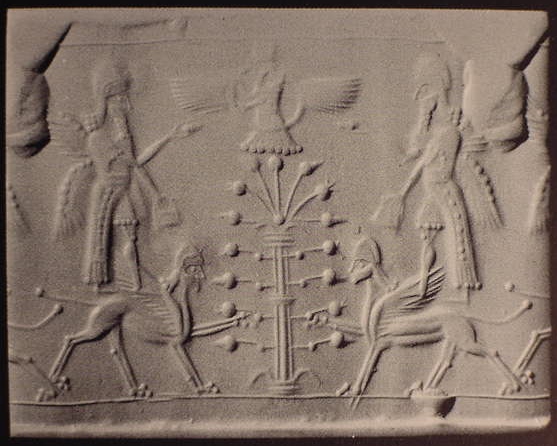Crowned and Winged Gods or Genii riding upon two Cherubim (winged Sphinxes) minister to the Sacred Tree (German: Lebensbaum, "Tree of Life") and winged Sun disc with the features of a god (8/7th century BCE ?). In the Hebrew Bible Yahweh-Elohim is described as winged and riding upon a Cherub ((cf. the book of Ruth 2:12 and Psalms 17:8; 36:7; 56:1 which speak of Yahweh's WINGS; and 2Sam 22:11; PS 18:10 mentioning the cherub Yahweh rides). The Cherubim were placed by Yahweh-Elohim in the Garden of Eden to deny mankind access to the sacred Tree of Life. Yahweh is also metaphorically likened to a winged sun disc by Malachi (Mal. 4:2). Yahweh' is apparently (metaphorically ?) described as possessing wings and likened to an eagle (Ex 19:4; PS 17:8, 36:7; Jer 48:40; Ruth 2:12). Cherubim are believed to be derived from Egyptian winged sphinxes of the New Kingdom period (1560-1200 BCE) and reworked by Phoenicians and Canaanites who in turned passed on the imagery to Israel. Solar imagery abounds in the bible in regards to God (He "dawns" from Seir in De 33:2, His temple faces the East and the rising sun), the Cherubim (sphinxes) originally being solar animals that at times faced the east and the rising sun, as in the Great Sphinx of Gizeh. In the above seal, the transformed Egyptian Winged Sun and its Sphinxes have been associated with the "Tree of Life." The Tree of Life (a transformed Egyptian Lotus, merged with a Datepalm), the Cherubim, the Winged Sun are all Egyptian motifs which have been reworked by Phoenicians, Canaanites, Syrians, Mesopotamians, and adopted by Israel and Judah.
(cf. p. 99. Paolo Matthiae. Geschichte der Kunst im Alten Orient, Die Grossreiche der Assyrer, Nuebabylonier und Achameniden, 1000-330 v. Chr. Stuttgart. Theiss. 1999. ISBN 3-8062-1437-9)
